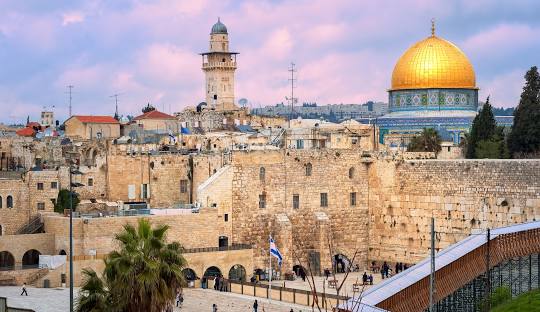Jerusalem throughout history: the permanent Arab and the contingent Jew
10/3/2004
The history of the city of Jerusalem dates back more than five thousand years, and thus it is considered one of the oldest cities in the world. The many names given to it indicate the depth of this history. The peoples and nations that settled in it gave it different names. The Canaanites who migrated to it in the third millennium BC called it “Ursalim,” which means the city of peace or the city of the god Salem. The word “Jerusalem” is derived from this name, which is pronounced in Hebrew as “yershalim” and means the Holy House. It was mentioned in the Torah 680 times. Then it was known in the Greek era as Aelia, which means the House of God. One of the most important works carried out by the Canaanites in Jerusalem was the construction of a tunnel to ensure the access of water into the city from the Gihon Spring, which is located in the Kidron Valley and which is known today as Spring of Silwan.
The original inhabitants of Jerusalem:
The Jebusite tribe – one of the Canaanite Arab clans – inhabited the city around 2500 BC, so they called it Jebus.
The Pharaonic era (16-14 BC)
The city of Jerusalem was subject to Egyptian Pharaonic influence starting in the 16th century BC. During the reign of King Akhenaten, it was invaded by the “Khapiru”, who were Bedouin tribes, and the Egyptian ruler Abdi Kheba was unable to defeat them, so the city remained in their hands until it returned again to Egyptian influence during the reign of King Seti I 1317 – 1301 BC.
The Jewish era (977 – 586 BC)
The Jews ruled Jerusalem for 73 years throughout its history, which extended for more than five thousand years. David was able to control the city in the year 977 or 1000 BC. He called it the City of David, built a palace and several fortresses in it, and his rule lasted 40 years. Then he was succeeded by his son Suleiman, who ruled it for 33 years.
After the death of Solomon, the state was divided during the reign of his son Rehoboam, and the city became called “Jerusalem,” a name derived from the Canaanite Arabic name Salem or Salem, which the Torah indicated was an Arab Jebusite ruler who was a friend of Abraham. (Genesis 14:18-20, and the Epistle to the Hebrews in the Gospel 6:20,7:1-5).
The Babylonian era (586 – 537 BC)
The Babylonian king Nebuchadnezzar II occupied the city of Jerusalem after defeating the last Jewish king, Zedekiah, son of Josiah, in 586 BC. He transferred the remaining Jews there as captives to Babylon, including King Zedekiah himself.
The Persian era (537 – 333 BC)
Then in 538 BC, the Persian king Cyrus allowed any of the Jewish prisoners he wanted in Babylon to return to Jerusalem.
advertisement
The Greek era (333 – 63 BC)
Alexander the Great took control of Palestine, including Jerusalem, in 333 BC. After his death, his successors, the Macedonians and the Ptolemies, continued to rule the city. In the same year, Ptolemy seized it and annexed it, along with Palestine, to his kingdom in Egypt in 323 BC. .M. Then in 198 BC, it became part of the Seleucids in Syria after Seleucus Nicator annexed it, and the population during that period was influenced by Greek civilization.
Jerusalem under Roman rule (63 BC – 636 AD)
The Roman army commander Pompeji captured Jerusalem in 63 BC and annexed it to the Roman Empire. The Roman rule of Jerusalem, which continued until the year 636 AD, witnessed many incidents. In the period from 66 to 70 AD, the Jews in Jerusalem carried out riots and civil disobedience, which were forcefully suppressed by the Roman ruler Titus, who burned the city and captured many of the Jews. Things returned to normal under the Roman occupation of the Holy City. Then the Jews returned to rebellion and declared disobedience twice in the years 115 and 132 AD, and they were actually able to control the city, but the Roman Emperor Hadrian dealt with them violently, and this resulted in the destruction of Jerusalem for the second time. He expelled the Jews residing there, leaving only the Christians. Then he ordered the name of the city to be changed to “ Ilia” and stipulated that no Jew should live there.
Church of the Resurrection
The Roman Emperor Constantine I moved the capital of the Roman Empire from Rome to Byzantium, and declared Christianity the official religion of the state. It was a turning point for Christians in Jerusalem, where the Church of the Resurrection was built in 326 AD.
The return of the Persians:
The Roman Empire was divided in 395 into two warring parts, which encouraged the Persians to raid Jerusalem and they succeeded in occupying it in the period from 614 to 628 AD. Then the Romans regained it again and it remained in their hands until the Islamic conquest in 636 AD.
The Night Journey (621 AD/10 AH)
In approximately the year 621, Jerusalem witnessed the visit of the Prophet Muhammad, may God bless him and grant him peace. He was taken on a night journey from the Sacred Mosque to Al-Aqsa Mosque and then ascended to the highest heavens.
advertisement
aFor the first Islamic era (636 to 1072 AD)
Caliph Omar bin Al-Khattab, may God be pleased with him, entered the city of Jerusalem in the year 636/15 AH (or 638 AD, depending on the sources) after the Islamic army led by Abu Ubaidah Amer bin Al-Jarrah had won, and Patriarch Sophronius stipulated that Omar should take over the city. He himself wrote with them the “Umri Covenant,” a document that granted them religious freedom in exchange for tribute. The name of the city was changed from Iliya to Jerusalem, and the document stipulated that no Jews would live there.
Since then, the city took on its Islamic character, and the Umayyads (661 – 750 AD) and Abbasids (750 – 878 AD) took interest in it, and it witnessed a scientific renaissance in various fields. One of the most important Islamic monuments in that period is the Dome of the Rock Mosque, which was built by Abd al-Malik ibn Marwan in the period from 682 to 691 AD. The Al-Aqsa Mosque was rebuilt in 709 AD. After that, the city witnessed instability due to the military conflicts that broke out between the Abbasids, Fatimids, and Qarmatians, and Jerusalem was subjected to Seljuk rule. Year 1071 AD.
Jerusalem during the Crusades
Jerusalem fell into the hands of the Crusaders in 1099 AD after five centuries of Islamic rule as a result of power struggles between the Seljuks and Fatimids and between the Seljuks themselves. Immediately upon entering Jerusalem, the Crusaders killed approximately 70,000 Muslims and violated Islamic sanctities. Since that date, a Latin kingdom was established in Jerusalem, ruled by a Catholic king who imposed Catholic rituals on Orthodox Christians, which sparked their anger.
The Second Islamic Era:
Saladin al-Ayyubi was able to recover Jerusalem from the Crusaders in 1187 AD after the Battle of Hattin. He treated its people well, removed the cross from the Dome of the Rock, and paid attention to building and fortifying the city.
The Crusaders again
, but the Crusaders succeeded in controlling the city after the death of Saladin during the reign of King Frederick, King of Sicily, and it remained in the hands of the Crusaders for 11 years until it was finally recovered by King Al-Salih Najm Al-Din Ayyub in 1244 AD.
advertisement
The Mamluks
The city was subjected to the Mongolian invasion in 1243/1244 AD, but the Mamluks defeated them under the leadership of Saif al-Din Qutuz and al-Zahir Baybars in the Battle of Ain Jalut in 1259 AD, and Palestine, including Jerusalem, was annexed to the Mamluks who ruled Egypt and the Levant after the Ayyubid state until 1517 AD.
The Ottomans
The Ottoman armies entered Palestine under the leadership of Sultan Selim I after the Battle of Marj Dabiq (1615 – 1616 AD), and Jerusalem became a city belonging to the Ottoman Empire. Sultan Suleiman the Magnificent rebuilt the city walls and the Dome of the Rock. In the period from 1831 to 1840 AD, Palestine became part of the Egyptian state established by Muhammad Ali and then returned to Ottoman rule again. In 1880, the Ottoman Empire established the Mutasarrifate of Jerusalem, and the old wall of the city was removed in 1898 to facilitate the entry of the German Kaiser William II and his entourage during his visit to Jerusalem. The city remained under Ottoman rule until World War I, in which the Ottoman Turks were defeated and expelled from Palestine.
British occupation (1917 – 1948 AD)
Jerusalem fell into the hands of the British army on 12/8/9/1917 after the statement broadcast by the British General Allenby. The League of Nations granted Britain the mandate over Palestine, and Jerusalem became the capital of Palestine under the British Mandate (1920 – 1948). Since then, the city entered into a new era, the most prominent feature of which was the increase in the number of Jewish immigrants to it, especially after the Balfour Declaration in 1917.
Jerusalem Internationalization Project:
The issue of Jerusalem was referred to the United Nations after World War II, and the international body issued its decision on November 29, 1947, to internationalize Jerusalem.
Ending the British Mandate
In 1948, Britain announced the end of the Mandate in Palestine and the withdrawal of its forces. Zionist gangs took advantage of the political and military vacuum and announced the establishment of the Israeli state. On December 3, 1948, Israeli Prime Minister David Ben-Gurion announced that West Jerusalem was the capital of the nascent Israeli state, while East Jerusalem was subject to Jordanian sovereignty until the defeat of June 1967, which resulted in the annexation of all of Jerusalem to the Israeli occupation authority


